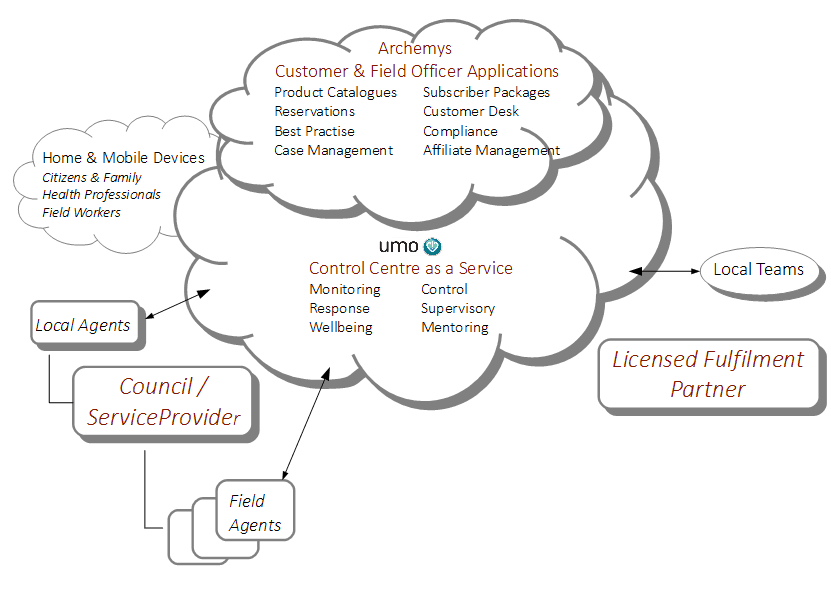TeleHealth as a Service is an applications ecosystem of proven applications and digital tools, closely integrated with skilled resources.
This is why TeleHealth as a Service adapts to the needs and policies of each organisation. In our management briefing sessions we provide comprehensive details of the potential and field specific issues and questions.
Traditional careline services have hardly changed since their inception. They’re still based upon an infrastructure that’s largely been superseded in many other fields. Our own experience ‘in the field’ led us to conclude that traditional services are generally unsustainable [not self-funding] and deliver only limited value to clients. Also that there are several groups of clients that were hardly served – if at all.
This has led to the development of TeleHealth as a Service to be completely responsive to specific, contextual goals.
Some Councils aim to leverage their basic careline service towards some level of sustainable telehealth and well-being services. Others simply wish to minimise costs whilst maintaining high standards. Some may elect to in-source skills and tools that ensure high quality services to residents whilst minimising operational costs.
To summarise, there’s several models from which an ideal turnkey solution can be custom configured:

- Move to Virtual & Enhanced Control Centre – assurance of 2025 compatibility
- Support Networked Agents – dedicated location unnecessary
- Co-Market Added-value Services – ethical communication and presentation of benefits
- Accredit Fulfilment Associates
- Managed Concierge Support
Virtual Control Centre
Using TeleHealth as a Service means there’s no longer a need to implement and operate a dedicated control centre, making relevant short term savings.
As a valuable by-product, a secure cloud-based control centre becomes immediately compatible with the UK’s change to a digital telephone system. This switch-over is due to be complete by 2025. However, it’s planned to scale back analogue services, such as ISDN, beginning 2020. Hence current careline services can’t wait until 2025. Experience in Europe indicates that failed alerts rates will rise during the next few years.
Networked Agents & Resources
Most current carelines either manage and operate their own teams at an in-house, traditionally equipped location or they contract one aspect of the process. Control centre agents and field officers are able to interact with TeleHealth as a Service from the most convenient, distributed locations.
Of course there’s some who’ve outsourced the complete service and TeleHealth as a Service enables them to reconsider this strategy via a very simple cost/benefit assessment. This is especially relevant where enhanced well-being can impact vulnerable residents, carers and sustainability.
Alongside this vital functionality, TeleHealth as a Service allows access to advanced capabilities for residents, families and care professionals. These capabilities meant that services may be provided by accredited, qualified third parties.
Ethical Co-Marketing
An absolutely critical lesson taken from our ‘coal-face’ experience with careline services is that clients are not engaged and valuable benefits are not clearly presented and understood. Rather the service is generally only accessible to those who take the trouble to investigate and too often lost in the depths of a large web site.
Hence a fundamental cornerstone of TeleHealth as a Service is the redevelopment of direct marketing strategies and tools in order to engage resident’s, families and health professionals. These customer groups need to be engaged sensitively whilst clearly getting across the value available to them. In parallel, the process of client boarding and assurance needs to be both effective and efficient for them.
TeleHealth as a Service can take on this key role in the progress towards self-sufficiency and positive community impact. Experienced resources are available and readily implemented. They are always executed in the name and identity of the service provider, in line with policies and with reporting to ensure oversight.
TeleHealth as a Service also manages an online, multi-vendor marketplace. This allows individual clients to make individual purchases of additional aids and devices that extend the usefulness of their service packages.
Accredited Resourcing
Most careline providers are having to minimise their full-time staff complement. Hence it’s often more cost efficient to deploy resources as needed.
TeleHealth as a Service manages an online ‘Centre of Excellence’ combined with Learning Management and best practise Behavioural Support. This underpins distributed access to systems and services outlined earlier. It means that operational costs are far more in line with actual client fulfilment, as approved and accredited external providers can be employed.
Fully Managed Turnkey Support
For those who recognise the benefits to each of these different communities, TeleHealth as a Service can also be implemented to replace and enhance an in-houe careline service. In other words, a Council is effectively delivering a growing range of services to all, retaining control of policy and client relationships. Operational activity.



